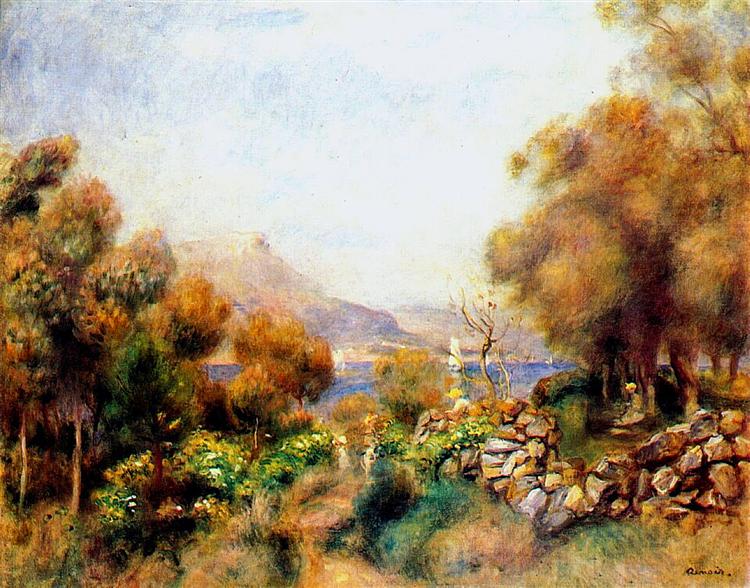Description
La peinture "Antibes" de Pierre-Auguste Renoir, réalisée en 1893, est un brillant exemple de la maîtrise de l'artiste dans la capture de la lumière, de la couleur et de la vie dans les paysages qui l'entouraient, en particulier dans le sud de la France. Renoir, une figure centrale du mouvement impressionniste, parvient à transmettre l'essence d'un moment éphémère, une caractéristique de son travail, dans lequel la technique impressionniste est combinée avec une sensibilité perspicace à la beauté naturelle et à la vie quotidienne.
Dans "Antibes", le paysage est déployé avec une palette riche qui varie du bleu profond de la mer Méditerranée au vert vibrant de la végétation, évoquant une sérénité lumineuse qui est à la fois rafraîchissante et enveloppante. La scène est dominée par la mer calme, qui capture la lumière réfléchie, créant des flashs qui dansent à sa surface. Le ciel, un bleu délicat, est doucement mélangé à des nuages qui semblent flotter paresseux, suggérant un environnement chaleureux et paisible.
La composition de l'œuvre est remarquable pour sa structure équilibrée. Au premier plan, la végétation est peinte avec des coups de pinceau lâches qui suggèrent le mouvement et la vie, tandis que l'horizon glisse doucement vers le fond, créant une profondeur qui invite le spectateur à glisser dans la scène. La technique de renouvellement, généralement caractérisée par son utilisation de coups de pinceau courts et qui se chevauchent, devient évident dans la manière dont la nature capture avec vivacité et une approche presque tactile, où la couleur et la lumière deviennent des protagonistes.
Bien que l'œuvre ne présente pas de figures humaines exceptionnelles, il y a un sentiment de présence vitale dans le paysage. Il s'agit d'une représentation caractéristique de l'approche de renouvellement, qui intègre souvent la figure humaine dans ses œuvres, mais ici le paysage lui-même devient un symbole de la vie vibrante du lieu. Cette approche peut être comprise comme une célébration de la fraîcheur de la vie extérieure que Renoir a trouvée en son temps en Côte d'Azur.
Les travaux sont enregistrés dans une série de paysages que Renoir a effectués pendant leurs séjours dans le sud de la France, où le climat, la nature légère et dynamique sont devenus des sources d'inspiration. Les tons chauds, ainsi que son utilisation audacieuse des couleurs, imprégnant la scène d'une énergie presque palpable, démontrent non seulement sa maîtrise technique, mais aussi son lien émotionnel profond avec l'environnement. Ces paysages, tels que les «antibes», sont fréquemment examinés et célébrés pour leur capacité à capturer l'atmosphère d'une époque et d'un lieu.
La pertinence des "antibes" se trouve également dans le contexte dans le développement de l'impressionnisme. Ici, vous pouvez voir les influences de la recherche de la lumière qui a caractérisé Renoir et ses contemporains. L'œuvre évoque non seulement une vision parfaite du sud de la France, mais offre également une réflexion sur l'idéal de la vie en plein air, qui résonne profondément à la fin du XIXe siècle et continue de le faire jusqu'à aujourd'hui. Ainsi, "Antibes" n'est pas simplement un paysage, mais une chanson à la vie, à la simplicité et à la beauté que l'impressionnisme savait si habilement comment capturer.
En conclusion, "Antibes - 1893" est une œuvre qui résume la maîtrise du renouvellement, révélant un style qui résonne encore dans l'art contemporain. Grâce à sa palette dynamique et à sa gestion de la lumière qualifiée, l'artiste parvient non seulement à documenter un endroit, mais aussi à transmettre une expérience uniforme de connexion avec l'environnement. La peinture est érigée comme un témoignage durable d'optimisme et de beauté qui émanent du monde naturel, marquant une étape importante dans l'histoire de l'art qui continue d'inspirer les générations.
KUADROS ©, une peinture célèbre sur votre mur.
Peintures à l'huile fabriquées à la main, avec la qualité des artistes professionnels et le sceau distinctif de KUADROS ©.
Service de reproduction des images avec garantie de satisfaction. Si vous n'êtes pas complètement satisfait de la réplique de votre peinture, nous remboursons votre argent à 100%.

